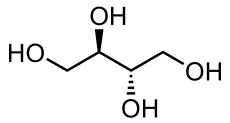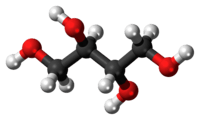Erythritol
 | |
 | |
| Names | |
|---|---|
| IUPAC name
(2R,3S)-butane-1,2,3,4-tetraol | |
| Identifiers | |
| 10030-58-7 | |
| ChEBI | CHEBI:17113 |
| ChEMBL | ChEMBL349605 |
| ChemSpider | 192963 |
| DrugBank | DB04481 |
| |
| Jmol-3D images | Image Image |
| KEGG | D08915 |
| PubChem | 222285 |
| |
| UNII | RA96B954X6 |
| Properties | |
| Molecular formula |
C4H10O4 |
| Molar mass | 122.12 g·mol−1 |
| Density | 1.45 g/cm³ |
| Melting point | 121 °C (250 °F; 394 K) |
| Boiling point | 329 °C (624 °F; 602 K) |
| Hazards | |
| NFPA 704 | |
| Except where noted otherwise, data is given for materials in their standard state (at 25 °C (77 °F), 100 kPa) | |
| | |
| Infobox references | |
Erythritol ((2R,3S)-butane-1,2,3,4-tetraol) is a sugar alcohol (or polyol) that has been approved for use as a food additive in the United States[1] and throughout much of the world. It was discovered in 1848 by British chemist John Stenhouse.[2] It occurs naturally in some fruit and fermented foods.[3] At the industrial level, it is produced from glucose by fermentation with a yeast, Moniliella pollinis.[1] Erythritol is 60–70% as sweet as sucrose (table sugar), yet it is almost noncaloric, does not affect blood sugar,[4] does not cause tooth decay,[5] and is partially absorbed by the body, excreted in urine and feces. It is less likely to cause gastric side effects than other sugar alcohols because of its unique digestion pathway. Under U.S. Food and Drug Administration (FDA) labeling requirements, it has a caloric value of 0.2 kilocalories per gram (95% less than sugar and other carbohydrates), though nutritional labeling varies from country to country. Some countries, such as Japan and the United States, label it as zero-calorie, while European Union regulations currently label it and all other sugar alcohols at 0.24 kcal/g.[6]
Erythritol and human digestion
In the body, most erythritol is absorbed into the bloodstream in the small intestine, and then for the most part excreted unchanged in the urine. About 10% enters the colon.[7] Because 90% of erythritol is absorbed before it enters the large intestine, it does not normally cause laxative effects, as are often experienced after consumption of other sugar alcohols (such as xylitol and maltitol),[8] although extremely large doses can cause nausea and borborygmi (stomach rumbling).[9]
Side effects
In general, erythritol is free of side effects in regular use. Doses over 50 grams (1.8 oz) can cause a significant increase in nausea and stomach rumbling (borborygmi).[9] Rarely, erythritol can cause allergic hives (urticaria).[10]
When compared with other sugar alcohols, it is also much more difficult for intestinal bacteria to digest, so is less likely to cause gas or bloating than other polyols,[7] such as maltitol, sorbitol, or lactitol.
Physical properties
Heat of solution
Erythritol has a strong cooling effect (endothermic, or positive heat of solution)[11] when it dissolves in water, which is often combined with the cooling effect of mint flavors. The cooling effect is present only when erythritol is not already dissolved in water, a situation that might be experienced in an erythritol-sweetened frosting, chocolate bar, chewing gum, or hard candy. The cooling effect of erythritol is very similar to that of xylitol and among the strongest cooling effects of all sugar alcohols.[12]
Blending for sugar-like properties
Erythritol is commonly used as a medium in which to deliver high-intensity sweeteners, especially stevia derivatives, serving the dual function of providing both bulk and a flavor similar to that of table sugar. Diet beverages made with this blend, thus, contain erythritol in addition to the main sweetener. Beyond high-intensity sweeteners, erythritol is often paired with other bulky ingredients that exhibit sugar-like characteristics to better mimic the texture and mouthfeel of sucrose. The cooling effect of erythritol is rarely desired, hence other ingredients are chosen to dilute or negate that effect. Erythritol also has a propensity to crystallize and is not as soluble as sucrose, so ingredients may also be chosen to help negate this disadvantage. Furthermore, erythritol is not hygroscopic, meaning it does not attract moisture, which can lead to the drying out of products, in particular baked goods, if another hygroscopic ingredient is not used in the formulation.
Inulin is often combined with erythritol because of inulin's offering a complementary negative heat of solution (exothermic, or warming effect when dissolved, which helps cancel erythritol's cooling effect) and noncrystallizing properties. However, inulin has a propensity to cause gas and bloating in those having consumed it in moderate to large quantities, in particular in individuals unaccustomed to it. Other sugar alcohols are sometimes used with erythritol, in particular isomalt, because of its minimally positive heat of solution, and glycerin, which has a negative heat of solution, moderate hygroscopicity, and noncrystallizing liquid form.
Erythritol and bacteria
Erythritol is tooth-friendly; it cannot be metabolized by oral bacteria, so it does not contribute to tooth decay.[5]
Erythritol as insecticide
Erythritol has been suggested as the active ingredient causing Truvia-induced impaired motor function and reduced life span in fruit flies.[13][14]
See also
- Threitol, the diastereomer of erythritol
- Stevia
- Erythritol tetranitrate
- Pentaerythritol
References
- ↑ 1.0 1.1 FDA/CFSAN: Agency Response Letter: GRAS Notice No. GRN 000076
- ↑ The discovery of erythritol, which Stenhouse called "erythroglucin", was announced in: Stenhouse, J. (January 1, 1848). "Examination of the proximate principles of some of the lichens". Philosophical Transactions of the Royal Society of London 138: 63–89; see especially p. 76. doi:10.1098/rstl.1848.0004.
- ↑ Shindou, T.; Sasaki, Y.; Miki, H.; Eguchi, T.; Hagiwara, K.; Ichikawa, T. (1988). "Determination of erythritol in fermented foods by high performance liquid chromatography" (PDF). Shokuhin Eiseigaku Zasshi 29 (6): 419–22. doi:10.3358/shokueishi.29.419.
- ↑ Noda, K; Nakayama, K; Oku, T (April 1994). "Serum glucose and insulin levels and erythritol balance after oral administration of erythritol in healthy subjects". European Journal of Clinical Nutrition 48 (4): 286–292. PMID 8039489.
- ↑ 5.0 5.1 Kawanabe, J.; Hirasawa, M.; Takeuchi, T.; Oda, T.; Ikeda, T. (1992). "Noncariogenicity of erythritol as a substrate". Caries Research 26 (5): 358–62. doi:10.1159/000261468. PMID 1468100.
- ↑ European Commission directive 2008/100/EC changed the energy conversion values of erythritol to zero calories:
- Erythritol is a polyol, and according to the current rules as provided for in Article 5(1) of Directive 90/496/EEC, its energy would be calculated using the conversion factor for polyols, namely 10 kJ/g (2.4 kcal/g). Using this energy conversion factor would not fully inform the consumer about the reduced energy value of a product achieved by the use of erythritol in its manufacture. The Scientific Committee on Food in its opinion on erythritol, expressed on March 5, 2003, noted that the energy provided by erythritol was less than 0.9 kJ/g (less than 0.2 kcal/g). Therefore it is appropriate to adopt a suitable energy conversion factor for erythritol.
- ↑ 7.0 7.1 Arrigoni, E.; Brouns, F.; Amadò, R. (November 2005). "Human gut microbiota does not ferment erythritol" (PDF). British Journal of Nutrition 94 (5): 643–6. doi:10.1079/BJN20051546. PMID 16277764.
- ↑ Munro, I. C.; Berndt, W. O.; Borzelleca, J. F. et al. (December 1998). "Erythritol: an interpretive summary of biochemical, metabolic, toxicological and clinical data". Food and Chemical Toxicology 36 (12): 1139–74. doi:10.1016/S0278-6915(98)00091-X. PMID 9862657.
- ↑ 9.0 9.1 Storey, D.; Lee, A.; Bornet, F.; Brouns, F. (Mar 2007). "Gastrointestinal tolerance of erythritol and xylitol ingested in a liquid". European Journal of Clinical Nutrition 61 (3): 349–54. doi:10.1038/sj.ejcn.1602532. PMID 16988647.
- ↑ Hino, H.; Kasai, S.; Hattori, N.; Kenjo, K. (Mar 2000). "A case of allergic urticaria caused by erythritol". Journal of Dermatology 27 (3): 163–5. PMID 10774141.
- ↑ Wohlfarth, C. (2006). CRC handbook of enthalpy data of polymer-solvent systems. CRC / Taylor & Francis. pp. 3–. ISBN 978-0-8493-9361-7.
- ↑ Jasra, R. V.; Ahluwalia, J. C. (1982). "Enthalpies of Solution, Partial Molal Heat Capacities and Apparent Molal Volumes of Sugars and Polyols in Water". Journal of Solution Chemistry 11 (5): 325–338. doi:10.1007/BF00649291. ISSN 1572-8927.
- ↑ http://news.sciencemag.org/plants-animals/2014/06/artificial-sweetener-poison-fruit-flies?rss=1
- ↑ http://dx.plos.org/10.1371/journal.pone.0098949
External links
| ||||||||||||||||||||||||||||||||||||||||||
